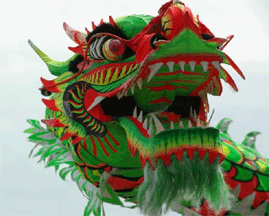
By Bernie Clark, December 12th, 2011
Many students who have participated in the Dragon Dance either live, or via MyYogaOnline have heard about the energetic benefits of this exuberant practice but few have heard of the mythic symbolism of the dance, which is quite entrancing.
The dance begins with the “Hero Advancing:” he is looking for a dragon to slay. Already we have our two prime characters in the dance, but who are they symbolically? In India, “kama” and “artha” are two of the four aims of life: kama is pleasure, artha is achievement. We find these two primal, animal drives arising as early as the nursery – I want that, I don’t want this. Whatever you have, I want too.
Kama is seeking that which pleases us and running away from that which we don’t like. This is the same desire and aversion that the Buddha realized was the cause of all our suffering in this life. Artha is our competitive drive, the urge to succeed materially in life, the desire for that juicy promotion, a bigger car, bigger house, and the need to keep up with the Jones. It is the will to power. The hero is driven in his quest by “I Want!”
The third aim in life is “dharma:” this is my personal dharma, my duty. It is what society, in the form of our families, our teachers, our clergy, our media, all demand of us. It is the role in life that we were born to play. It is of dharma that Krisna talks when he urges Arjuna to get in there and join the battle in the great epic The Bhagavad Gita. Go! Do your duty! Don’t be concerned with success or failure; just do what you were born to do. We are being told to be the good soldier or good citizen or good consumer and do what society is asking of us. That is dharma.
Dharma is the dragon. Nietzsche once named this dragon, “Thou Shalt!” Each of its scales has a law written upon it; a rule of society, of our culture, that we must follow. “Thou Shalt!” is the dragon that the hero wants to conquer. The dance now begins.
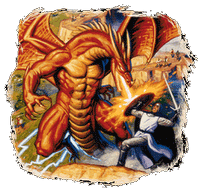 Here we are presented with the quandary of our times – which is more important: my expression of individuality or my submission to the way things are? This is the battle of every teenager who is trying to figure out, “What is my purpose in life?” Do I try to fit in, as society is demanding, or do I seek my own individual path? If I try to fit in, things go smoothly but at a cost of feeling unfulfilled. If I try to express my own unique personality, to follow my own dreams and live the authentic life I want to live, my friends and family become alienated and frightened.
Here we are presented with the quandary of our times – which is more important: my expression of individuality or my submission to the way things are? This is the battle of every teenager who is trying to figure out, “What is my purpose in life?” Do I try to fit in, as society is demanding, or do I seek my own individual path? If I try to fit in, things go smoothly but at a cost of feeling unfulfilled. If I try to express my own unique personality, to follow my own dreams and live the authentic life I want to live, my friends and family become alienated and frightened.
We are caught on the horns of two ancient conventions: the Greek urge to express our unique individual nature captured in modern secular times as our inalienable human rights, and the Levantine commandment to surrender to God and do his will. This conflict is aptly symbolized by Prometheus, the hero who defied god (Zeus), was justly punished and did not repent, and by Job, who was unjustly punished by God but repented despite the fact that he had done no wrong.
 In the Dragon Dance, the hero first advances: the “I Want” seeks to slay the dragon of “Thou Shalt!” In the second act, the Dragon turns and sees the hero approaching: society is watching you! Do you really think that you can sneak up on your own culture?
In the Dragon Dance, the hero first advances: the “I Want” seeks to slay the dragon of “Thou Shalt!” In the second act, the Dragon turns and sees the hero approaching: society is watching you! Do you really think that you can sneak up on your own culture?
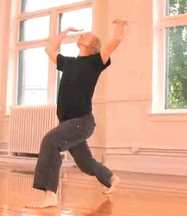 In the third act, the dragon rears up and spreads its wings, ready to take flight. “Thou Shalt!” is not easily subdued. The fourth act sees the dragon diving back to earth, ready to assault the hero and bring him back in line. The dragon is above you, larger and stronger than you. How can you hope to defeat it?
In the third act, the dragon rears up and spreads its wings, ready to take flight. “Thou Shalt!” is not easily subdued. The fourth act sees the dragon diving back to earth, ready to assault the hero and bring him back in line. The dragon is above you, larger and stronger than you. How can you hope to defeat it?
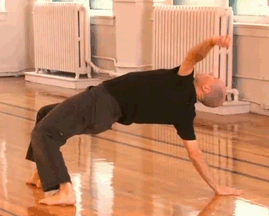 Act five: the dragon swings his scaly tale at the hero: retribution is at hand. Act six: the hero ducks under the dragon narrowly avoiding being bludgeoned back into his proper place in society.
Act five: the dragon swings his scaly tale at the hero: retribution is at hand. Act six: the hero ducks under the dragon narrowly avoiding being bludgeoned back into his proper place in society.
At this point in the dance several things could happen. The hero has stepped under the belly of the beast and from here can deliver a killing blow into its exposed heart, but there is another choice.
The fourth aim of life, beyond kama, artha and dharma, is “moksha.” Moksha is release, liberation, ultimate freedom from desire and duty. In India, when a man has completed his worldly tasks, when he has raised his family and the eldest son is ready to take over as head of the household, he heads to the forest to practice yoga. (Women can do this too, but rarely do women choose this path.)
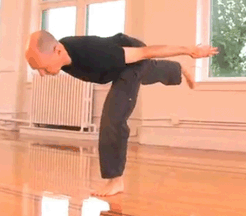 We can choose to slay the dragon “Thou Shalt!” and become a rebel living outside the laws of custom, culture and family, or we can choose to transcend pleasure and duty altogether. Moksha is going beyond the three lesser aims of life. Through our yoga practice we yoke the hero and the dragon together. This is the last act of the dance: the hero spirals around the dragon and mounts it. The dragon is not slain, only tamed. Together the hero and the dragon rise up: now is the time to take to the air, to transcend.
We can choose to slay the dragon “Thou Shalt!” and become a rebel living outside the laws of custom, culture and family, or we can choose to transcend pleasure and duty altogether. Moksha is going beyond the three lesser aims of life. Through our yoga practice we yoke the hero and the dragon together. This is the last act of the dance: the hero spirals around the dragon and mounts it. The dragon is not slain, only tamed. Together the hero and the dragon rise up: now is the time to take to the air, to transcend.
In the West, we have recognized these characters psychologically. Freud has named kama and artha, libido and id. Dharma, our dragon, he calls the superego. This is an old story: “I want” versus “thou shalt.” Carl Jung has offered a path to resolution via the process of individuation: a complete sculpting of the Western ego so that is free from the imperatives of desire and duty.
(Ego in the West is not the same as what is meant by ego in the East! In the East, ego is simply libido and id: desire for pleasure and power. In the West ego is much more complicated: it is the psychic interface between all that is unconscious and that which is the “real” world outside ourselves. In the East we are urged to kill the ego, which means we should stop our greed and hatred. In the West are urged to develop our ego, which means to become whole people, not the part people society would have us to be.)
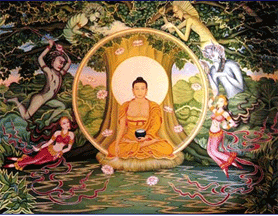 This myth has been rendered in different terms in the story of the night of the Buddha’s enlightenment and his three temptations. As the Buddha sits in the unmovable spot beneath the great tree at the centre of all things, Mara, the great shadow, approaches him. Seeking to prevent the Buddha’s enlightenment Mara invokes Kama who sends to the Buddha his three lovely daughters: Lust, Fulfillment and Regret. The beautiful daughters of Kama try to seduce the Buddha but he does not react: he has moved beyond desire and libido. Next Mara summons Yama, the Lord of Death, and Yama hurls his great army at the Buddha in an attempt to frighten the Buddha into moving. The Buddha remains steady: he has moved beyond fear and id. Neither kama nor artha can move the Buddha: the hero remains still.
This myth has been rendered in different terms in the story of the night of the Buddha’s enlightenment and his three temptations. As the Buddha sits in the unmovable spot beneath the great tree at the centre of all things, Mara, the great shadow, approaches him. Seeking to prevent the Buddha’s enlightenment Mara invokes Kama who sends to the Buddha his three lovely daughters: Lust, Fulfillment and Regret. The beautiful daughters of Kama try to seduce the Buddha but he does not react: he has moved beyond desire and libido. Next Mara summons Yama, the Lord of Death, and Yama hurls his great army at the Buddha in an attempt to frighten the Buddha into moving. The Buddha remains steady: he has moved beyond fear and id. Neither kama nor artha can move the Buddha: the hero remains still.
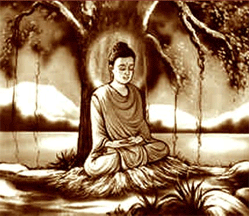 Next Mara summons the god Dharma who berates the Buddha. “Why are you sitting here? You lazy man! Your place is beside your father. You are born to rule, to be king after your father. Go home and perform your duty!” Dharma, the superego, fails to move the Buddha as well: the Buddha in a simple gesture touches the earth. She speaks in his defense and dismisses the dragon. As in the Dragon Dance, the Buddha transcends the first three aims of life and finds a new path – a path to freedom.
Next Mara summons the god Dharma who berates the Buddha. “Why are you sitting here? You lazy man! Your place is beside your father. You are born to rule, to be king after your father. Go home and perform your duty!” Dharma, the superego, fails to move the Buddha as well: the Buddha in a simple gesture touches the earth. She speaks in his defense and dismisses the dragon. As in the Dragon Dance, the Buddha transcends the first three aims of life and finds a new path – a path to freedom.
Freedom does not mean license. This is not freedom to do what you want and not do what you don’t want, but a freedom from wants. Of course, it is not just the Dragon Dance that leads to this ultimate contentment – now that you are aware of these mythological symbols, you are free to see this journey unfolding in any dance you choose to perform. It is really the dance of my life.
(Back to Newsletter #9)
